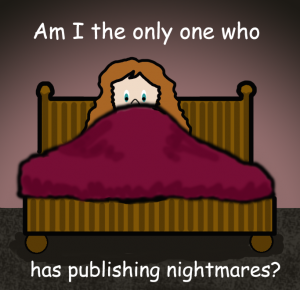By the end of the year, I grew more dissatisfied with my situation. My “publisher” was keeping me bogged down in the marketing where I had no skills and no experience. They thrust me into a senior-level job as a marketing and social media specialist with expectations to produce spectacular results after sixteen weeks of on-the-job training and being paired with a “mentor.”
My manuscript never got near an editor’s desk.
I read the articles on SFWA’s Writer Beware blog and corresponded by email with Victoria Strauss herself. I discussed my frustrations with close friends—a freelance professional editor and a couple of authors with publishing credits at the major houses like Harper-Collins and DAW. Their support and friendship validated what I knew in my gut to be true. I was in a bad situation.
- A-to-Z Publishing demanded that I work as hard to market myself as if I were a self-published author. Yet they denied me all control over the launch schedule, the choice of editor, and the cover design—contrary to my expectations of a boutique small press.
- Their brand label had no commitment to quality. The books they produced ahead of mine showed sloppy editing riddled with grammatical errors. They used what were clearly cut-and-paste stock images on their cover art.
- Their projected sales goals aspired to those of major commercial publishers, but A-to-Z lacked the capital to build a platform to help me achieve those goals.
- They would never contact any reviewers or bloggers on my behalf nor did they establish any relationships with such as contacts for their authors. Instead, I would be in line with countless self-pubbed authors begging to bloggers for attention. Forget about a review in Publisher’s Weekly or Locus or being featured in the books section of my Sunday newspaper.
- A-to-Z would never get me distributed into any brick-and-mortar bookstore, even the small independent ones. In fact, they discouraged me from arranging any personal appearances in a bookstore on the premise that bookstores were “boring” relics headed for the dust bin of history. Perhaps it’s different in other parts of the country, but where I live in the San Francisco Bay Area, bookstores are not dead!
What advantages did they really offer to be earning a hefty cut of my profits? None.
Even so, it was very hard to let go of my dream. Like the workhorse in George Orwell’s Animal Farm, I kept trying harder and harder. Believe me, none of the authors in A-to-Z’s catalog put in more hours and more effort with so little results. Or, as the marketing folks say, ROI—return on investment. I studied Guy Kawasaki’s marketing books. I watched YouTube videos. I read a bunch of blogs. I learned about SEOs, Google analytics, the algorithms that Facebook uses to filter the news feed, the difference between outbound (spam) and inbound marketing, and the application of psychology techniques in advertising. Overthinking it? Perhaps. I realized that sales and marketing folks think about these things a lot. They get really excited to blog about metrics, clicks and sticky views, conversions from leads, tracking sales spikes correlated to their activity on social media, and so on. God bless ’em, but this stuff bores me.
Ironically, one of the lessons in A-to-Z’s seminar had us take a look at what other successful authors do and analyze how they got there. George R. R. Martin (Game of Thrones) started as a script writer in Hollywood over thirty years ago and has worked his way up the food chain. Brandon Sanderson is an up-and-coming fantasy author with a background in missionary work. In other words, he knows how to knock on doors and talk to people. Aha! Light bulb moment. Like any professional career, successful authors put time and effort into networking in their field. Clearly, it takes years of diligent effort and marketing savvy to build up a fan base. There are no shortcuts, no magic wand, no fast track to success.
I asked to be released from my contract. At first, they said no. “We have been honoring our side of the contract, and I cannot release the book to you after investing this much in you.” My mother’s fighting spirit flared to life in my gut. I pushed back, citing that the contract obligated A-to-Z to publish my book within eighteen months of receiving the complete manuscript. That deadline had passed. They stonewalled me until I threatened legal action. Thankfully, I never had to go to court—but I was ready to fight.
I’m fortunate that, with some perseverance, I recovered all the rights to my manuscript. I am free to self-publish or send out queries once more. Back to square one. Except that I no longer feel so desperate and hopeless that I’ll sign anything just for the chance of seeing my name in print. If I grow old and die without ever seeing a novel commercially published in a SFWA qualifying market, I am okay with that. Now I have the confidence to walk away from a bad deal, and thanks to this experience, I’ve learned how to spot one.
So what’s a poor struggling first-time author to do? Arm yourself! You spent a long time writing your book, so spend a little extra researching where to find a good home for it. Here are some places to start.
The Peril of Author Mills: Victoria Strauss discusses the siren allure of the author mills that lure in inexperienced first time writers and reveals the nightmare they can become.
The Writer’s Dig: Editor Robert Lee Brewer of the Writer’s Digest discusses the small press as a publishing option.
Writer Beware—Contests and Awards: SFWA blog discussing the pros and cons of contests and awards.
Writer Beware—Small Presses: SFWA blog discussing issues to consider when submitting to a small press.




Pingback: My Descent into Publishing Purgatory: Part 4— Good-bye Professor Higgins - Leasspell